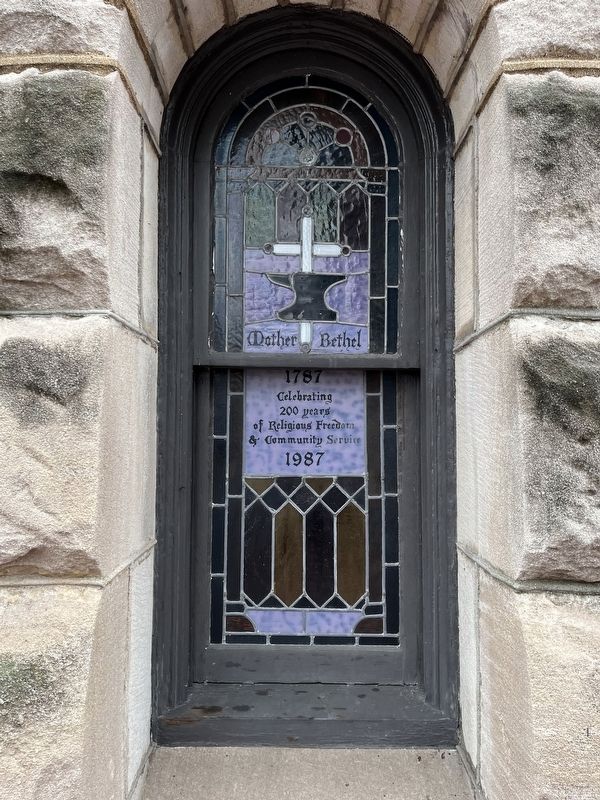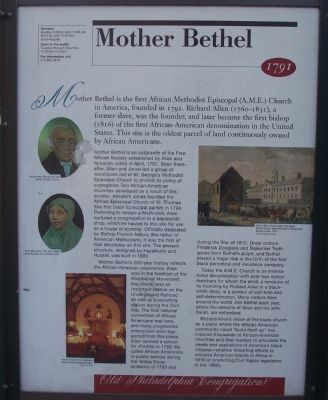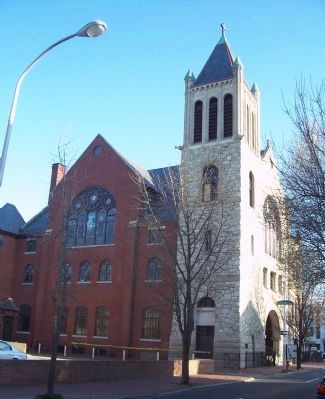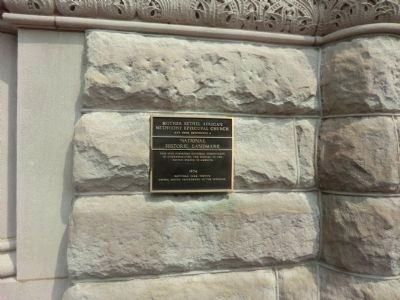Society Hill in Philadelphia in Philadelphia County, Pennsylvania — The American Northeast (Mid-Atlantic)
Mother Bethel
1791
— Old Philadelphia Congregations —
Mother Bethel is the first African Methodist Episcopal (A.M.E.) Church in America, founded in 1791. Richard Allen (1760-1831), a former slave, was the founder, and later became the first bishop (1816) of the first African-American denomination in the United States. This site is the oldest parcel of land continuously owned by African Americans.
Mother Bethel is an outgrowth of the Free African Society established by Allen and Absalom Jones in April, 1787. Soon thereafter, Allen and Jones led a group of worshipers out of St. George's Methodist Episcopal Church to protest it policy of segregation. Two African-American churches developed as a result of this exodus. Absalom Jones founded the African Episcopal Church of St. Thomas (the first Black Episcopal parish) in 1794. Preferring to remain a Methodist, Allen nurtured a congregation in a blacksmith shop which he hauled to this site for use as a house of worship. Officially dedicated by Bishop Francis Asbury (the father of American Methodism), it was the first of four structures on this site. The present structure, designed by Hazelhurst and Huckel, was built in 1889.
Mother Bethel's 200 year history reflects the African-American experience. Allen was in the forefront of the Abolitionist Movement; the church was an important station on the Underground Railroad as well as a recruiting station during the Civil War. The first national convention of African-Americans met here and many progressive enterprises were supported from this place. Allen opened a school for children in 1795. He called African Americans to public service during the Yellow Fever epidemic of 1793 and during the War of 1812. Great orators, Frederick Douglass and Sojourner Truth spoke from Bethel's pulpit, and Bethel played a major role in the birth of the first Black periodical and insurance company.
Today, the A.M.E. Church is an international denomination with over two million members for whom the anvil, a reminder of the founding by Richard Allen in a blacksmith shop, is a symbol self-help and self-determination. Many visitors from around the world visit Bethel each year, where the remains of Allen and his wife, Sarah, are entombed.
Richard Allen's vision of the Black church as a place where the African-American community could "build itself up" has inspired thousands of African-American churches and their leaders to articulate the needs and aspirations of America's Black citizens - whether thwarting efforts to colonize American Blacks in Africa in 1816 or promoting Civil Rights legislation in the 1960s.
[Captions:]
Richard Allen, founder and first bishop, A.M.E. Church.
Sarah Allen (born Isle of Wight County,
Interior of church from horseshoe balcony toward pulpit and organ.
"Gaol in Walnut Street" (which may depict Mother Bethel's blacksmith shop in foreground), W. Burch & Son, 1799. American Philosophical Society
Erected by Old Philadelphia Congregations.
Topics and series. This historical marker is listed in these topic lists: Abolition & Underground RR • African Americans • Churches & Religion • Civil Rights. In addition, it is included in the African Methodist Episcopal (AME) Church, the Francis Asbury, Traveling Methodist Preacher, and the National Historic Landmarks series lists. A significant historical month for this entry is April 1787.
Location. 39° 56.603′ N, 75° 9.118′ W. Marker is in Philadelphia, Pennsylvania, in Philadelphia County. It is in Society Hill. Marker is at the intersection of South 6th Street and Addison Street, on the left when traveling south on South 6th Street. Touch for map. Marker is at or near this postal address: 419 South 6th Street, Philadelphia PA 19147, United States of America. Touch for directions.
Other nearby markers. At least 8 other markers are within walking distance of this marker. Mother Bethel African Methodist Episcopal Church (here, next to this marker); a different marker also named Mother Bethel African Methodist Episcopal Church (here, next to this marker); Mother Bethel A.M.E. Church
(a few steps from this marker); In Tribute to the Emanuel Nine (within shouting distance of this marker); The Richard Allen Statue and Memorial Courtyard (within shouting distance of this marker); The Philadelphia Tribune (within shouting distance of this marker); Free African Society (within shouting distance of this marker); Richard Allen (within shouting distance of this marker). Touch for a list and map of all markers in Philadelphia.
Related markers. Click here for a list of markers that are related to this marker. Other markers related to Absalom Jones
Also see . . . Mother Bethel A.M.E. (on Virtual Tour of Historic Philadelphia). (Submitted on April 2, 2008, by Richard E. Miller of Oxon Hill, Maryland.)
Additional keywords. Black Methodism

Photographed By Devry Becker Jones (CC0), January 27, 2024
4. Stained glass commemorating the congregation’s bicentennial
Credits. This page was last revised on April 16, 2023. It was originally submitted on April 2, 2008, by Richard E. Miller of Oxon Hill, Maryland. This page has been viewed 2,759 times since then and 43 times this year. Photos: 1. submitted on April 2, 2008, by Richard E. Miller of Oxon Hill, Maryland. 2. submitted on April 16, 2023, by Devry Becker Jones of Washington, District of Columbia. 3. submitted on April 2, 2008, by Richard E. Miller of Oxon Hill, Maryland. 4. submitted on January 29, 2024, by Devry Becker Jones of Washington, District of Columbia. 5. submitted on May 19, 2015, by Don Morfe of Baltimore, Maryland. • Christopher Busta-Peck was the editor who published this page.

![Mother Bethel Marker [Reverse]. Click for full size. Mother Bethel Marker [Reverse] image. Click for full size.](Photos7/717/Photo717391.jpg?416202360500PM)

